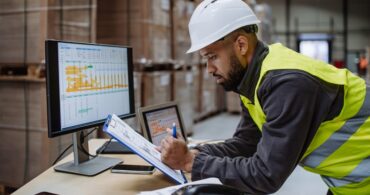Sometimes referred to as a forklift capacity plate or forklift name plate, a forklift data plate might be the most helpful feature on the machine. With a glance, an operator can immediately learn the information necessary to drive the machine securely.
According to the Occupational Safety and Health Administration (OSHA), there are nearly 100,000 forklift accidents per year. Serious injuries result from 35,000 of those accidents, and approximately 85 are fatal.
Not every accident is preventable. That’s why they’re called accidents. However, in many cases, the cause was the improper operation of the vehicle (42% of forklift fatalities were due to the vehicle tipping over). Whether that means driving too fast or carrying a load improperly, some of these accidents, injuries and fatalities were preventable with some care and caution.
Part of the safe operation of a forklift is ensuring that you stay within the carrying capacity of the vehicle. To know that at a glance, you must understand how to read the forklift data plate.
Capacity plate forklift information
OSHA requires that all forklifts include a forklift plate (regulations 29 CFR 1910.178(a)(3)—(6)). If any modifications are made to the forklift, the original forklift name plate needs to be replaced with a new one. Contact an authorized forklift dealership or a professional engineering firm to order a new name plate.
The forklift data plate is either on the instrument panel near the controls or the engine hood next to the seat. It is the operator’s responsibility to review the information on the dataplate so they understand the tasks the machine can—and cannot—perform. If a forklift is missing a label or parts of it are illegible, the machine should not be used until the label is replaced.
How to read a forklift data plate
The information on specific capacity plates will differ from machine to machine depending on manufacturer, model and type of forklift (for example, electric forklifts provide specs on voltage and battery type while gas-powered machines, obviously, don’t). However, there is some info found on every forklift capacity plate.
Model number
If a forklift needs parts or repairs, the model number is the first information you need to communicate with the manufacturer or a forklift mechanic.
Serial number
Like the model number, the serial number is vitally important when communicating with the manufacturer or a technician. In fact, since the serial number is unique to the machine, it may be more important. A serial number allows a technician to access the forklift’s record and see if the unit has a different design than other forklifts in the same model series.
Manufacture year
Ever wondered what year a forklift was manufactured? Well, this is how you find out. This information helps with communication, repair, technician, etc. (see above).
Power type
This is the energy source for the forklift:
- CNG is compressed natural gas
- D is diesel.
- E is electricity.
- G is gasoline.
- LPG is liquid propane gas.
The forklift data plate for electric forklifts provides additional information, including:
- Voltage.
- Amp-hour rating.
- Battery weight (see below).
Weight
For a gas-powered forklift, this section provides the weight of the entire machine, including any attachments (without a load).
For an electric forklift, this section only gives the weight of the chassis and any attachments. It omits the weight of the battery. This is so you can know the accurate forklift weight even after a battery change. To find the total weight of an electric lift truck, you need to add the forklift’s weight to the weight of the battery (which is printed on the battery).
Mast type
Forklifts have different types of masts depending on the model. Usually, the mast type is identified with an abbreviation, such as:
- 2-stage (V or FV).
- 3-stage (FSV or TSU).
- 4-stage (QFV).
Back tilt
Back tilt lets you know how far back (toward the operator) the mast can tilt. This information is provided in degrees.
Tire information
A variety of tire information may be found on the forklift data plate, including:
- Front tire tread (width of the front wheels).
- Tire size.
- Tire type (cushion tires are listed as “solid,” while air-filled tires list the recommended PSI).
Attachments
Because attachments add weight and reduce lifting capacity, they are included on capacity plates. In addition, attachments have supplemental data plates with information like:
- Model number.
- Serial number (for attachments with hydraulics).
- Manufacture year.
- Maximum hydraulic pressure.
- Weight.
- Load center.
- Capacity.
- A warning that the listed capacity may be less than the actual capacity (and to check the truck data plate).
Forklift load capacity
A forklift’s load (or weight) capacity is listed in a forklift load chart. This capacity is based on several different factors.
How to read forklift load capacity chart
The following information is included on the forklift load chart.
Load center
The load center is a load’s center of gravity when measured horizontally from the front of the forks and vertically from the top of the forks. Most forklifts have a 24-inch load center. Generally, lift trucks with high load centers can lift less than those with low ones.
Maximum lift height
This is how high the mast extends, based on the “mast type” (see above).
Load capacity
This is the maximum weight the forklift can handle. Load capacity is calculated based on the load center, maximum lift height and any attachments. Maximum load capacity also assumes perfect conditions. It’s crucial that operators remember the maximum capacity can change due to many factors.
The forklift load chart may include a diagram of a forklift with parts labeled A through c.
- A is the horizontal distance for the load center.
- B is the vertical distance for the load center.
- C is the lift height.
The values for A-C are listed on the forklift load chart to clearly show how the forklift load capacity is calculated.
If you’d like to discuss the forklift data plate further, especially how the forklift battery and accessories impact forklifts, please reach out to our forklift repair service team at (888) 316-2459. You can also fill out this form to learn about our services and discover everything Texas Motive Solutions can do for you.



